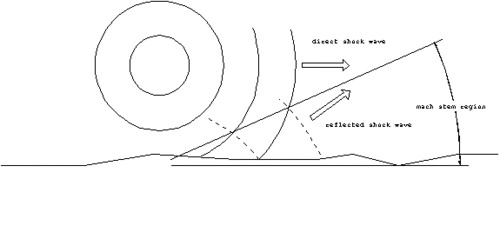Mach effect
When explosives detonate in air, and the altitude of the burst is sufficiently low that the blast wave reflects from the ground, the Mach effect describes the interactions between the direct warhead pressure wave and the reflected wave, to predict the overpressure that will affect various structures on the surface of the earth. If the detonation altitude is sufficiently high that there is no significant reflection, the surface will only receive direct blast, thermal effects, and, if the explosion is nuclear, ionizing radiation.
"At some distance away, the two waves will come together and create a region with even greater blast effects. This is known as the mach stem region.
In this region, both the peak overpressure and the dynamic pressure will be almost double what would be felt if the warhead had detonated on the ground. The height above ground which maximizes this effect at a particular range is called the optimum height of burst. This is used to determine the setting for the detonator. Although this effect can greatly increase the effective range of some weapons, it only has practical application to very large bombs, and nuclear warheads. For smaller warheads, the extra distance from the target resulting from the detonation above the ground more than compensates for the increased pressures in the mach stem region.[1]
- ↑ U.S. Navy, Chapter 31, Warheads, ES101 course on weapons engineering, Federation of American Scientists
